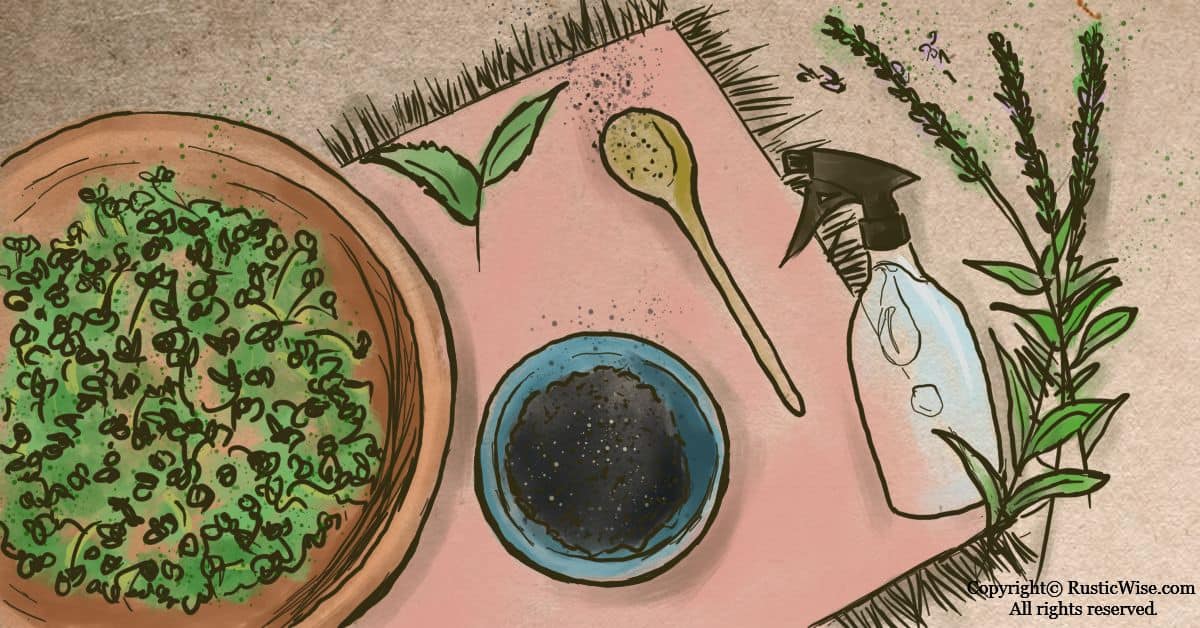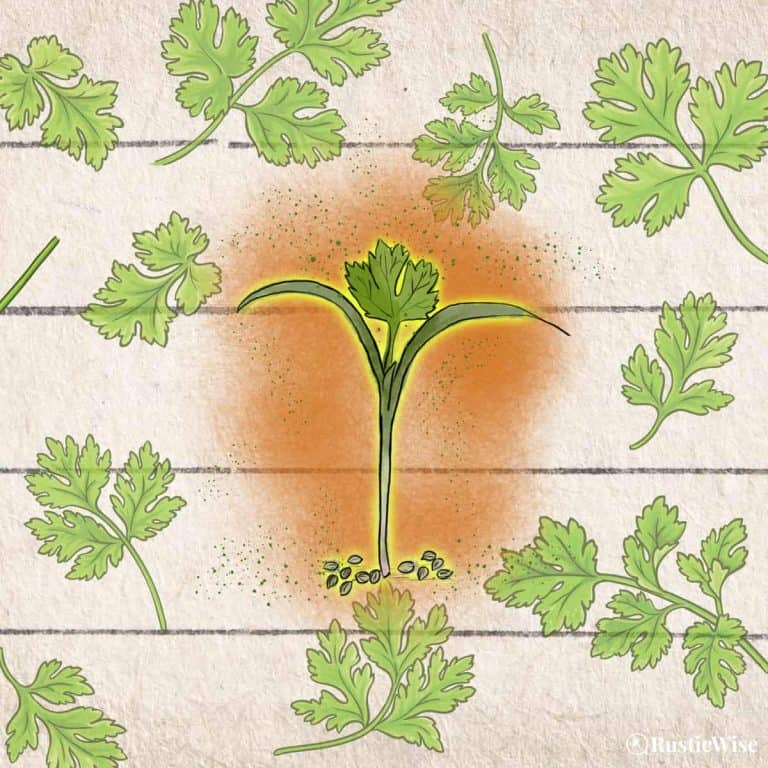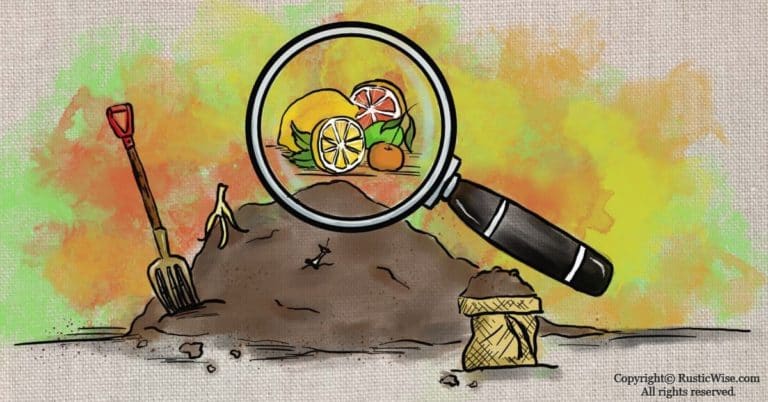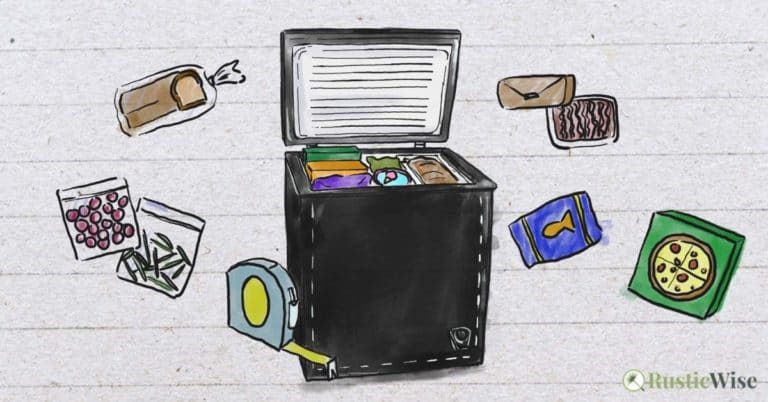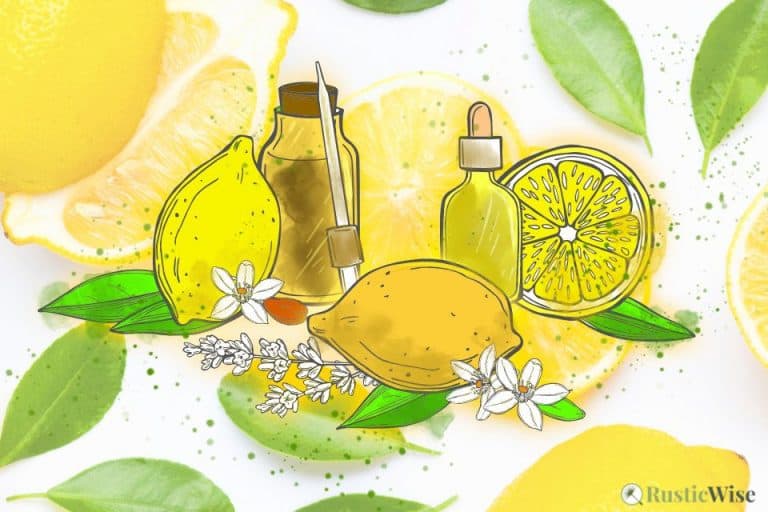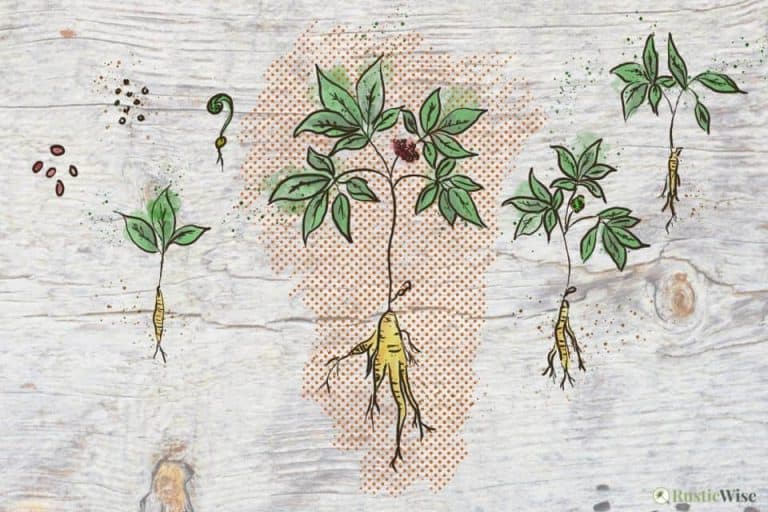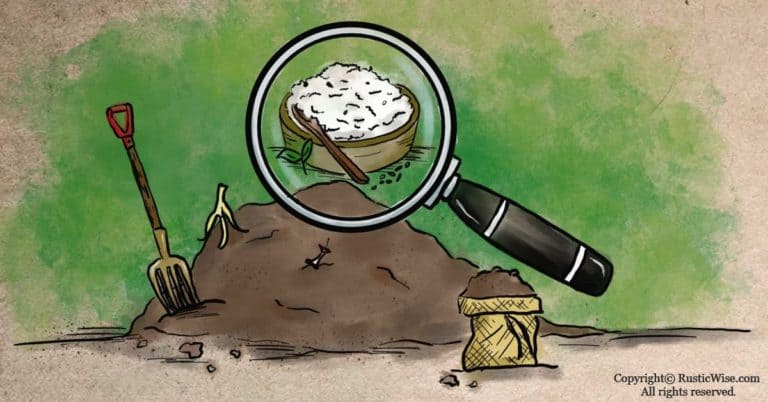How To Grow Chia Sprouts 3 Ways (Quick and Easy!)
RusticWise is supported by its readers. When you purchase through links on our site, we may earn an affiliate commission. As an Amazon Associate, we earn from qualifying purchases. Thank You!
Chia seeds are packed with protein, fiber, and omega-3s. While you can sprinkle chia seeds on top of cereal, or make chia pudding, learning how to grow chia sprouts opens up a new way to include this superfood into your diet. Store-bought chia sprouts are pricey. Luckily, sprouting chia at home is easy.
There are many ways to sprout seeds at home. As chia seed is mucilaginous, it doesn’t take well to the rinse and drain method we use with sprouting jars. Instead, I’ll show you how to grow chia sprouts using a terracotta dish, or a hemp bag. You can also try growing microgreens with a growing medium.
Let’s learn more about the health benefits of chia and how to grow chia sprouts!
A closer look at chia seeds and the chia plant
Chia seeds come from the Chia plant (Salvia hispanica) which is a flowering plant that belongs to the mint family.¹
The seeds range in color from dark-brown to white and have long been touted for their nutritional contents, rich in dietary fiber and healthy fats.
Chia grows naturally in Guatemala and Mexico. It was a diet staple in ancient Aztec and Mesoamerican Indian groups. Now it’s grown commercially in many countries such as Argentina, Australia, Peru, and the United States.
Health benefits of chia
Adding more chia to your diet is a great way to add a dose of nutrients . Its protein-rich profile helps you feel satiated. When you think of protein-rich foods packed with healthy omega-3s, fish probably pops up first. Surprisingly, chia is also a rich source of omega-3s—great news for vegans and vegetarians. (Other seeds rich in this healthy fatty acid are flax and hemp.)
Here’s a fun fact: Chia seeds contain the highest level of omega-3s of all plant-based foods (according to The Sprout Book by Doug Evans).²
A 1-ounce (28 grams) serving of chia seeds has 138 calories. Here’s the nutritional breakdown of chia seeds:³
- 4.7 grams protein (9 percent DV)
- 8.7 grams fat (11 percent DV)—note that the majority of fats are “healthy fats” from omega-3s, and to a lesser degree omega-6s.
- 9.8 grams fiber (35% DV)
- 179 milligrams calcium (14 percent DV)
- 2.2 milligrams iron (12 percent DV)
- 244.2 milligrams phosphorus (20 percent DV)
- 95.1 milligrams magnesium (23 percent DV)
- 1.3 milligrams zinc (12 percent DV)
So what are omega-3s good for? Here’s just a few benefits:²
- Promotes a healthy heart. Chia helps to lower blood pressure while also raising “good” (HDL) cholesterol.
- Prevents blood clots.
- Reduces inflammation.
- Reduces the chance of adult-onset diabetes by helping to manage insulin resistance.
- Plays an important role in the nutrition of pregnant women to promote the development of a healthy brain in infants.
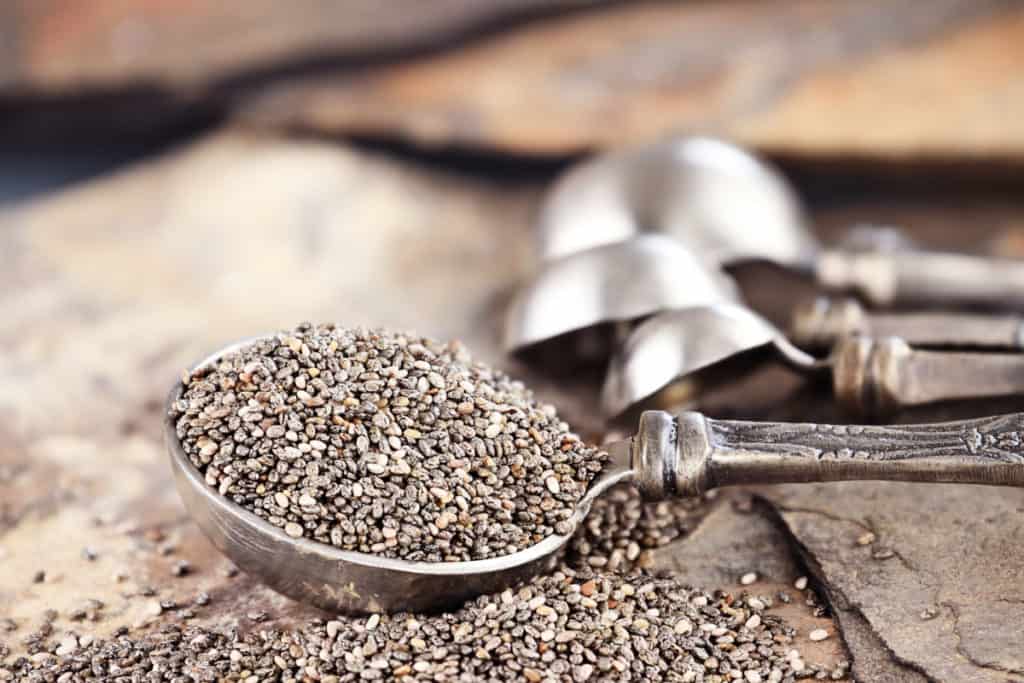
Why grow chia sprouts?
Chia seed pudding is a mainstay in our home for breakfast. Besides making pudding, or sprinkling it over cereals and salads, we can also sprout chia seeds.
Why bother growing chia sprouts?
Well, besides introducing chia in the form of a healthy green which you can add to salads and sandwiches, the sprouting process helps unlock nutrients.
Seeds have a hard outer layer which is often difficult to digest and inhibits the absorption of vitamins and nutrients.
The act of sprouting helps break down the outer layer of seeds. This enables our bodies to more readily access vitamins and nutrients we normally couldn’t. With chia, we can tap into a rich source of omega-3s, protein, and fiber.
Sprouted seeds are also easier to digest. Sprouts also have more nutrients than their fully grown counterparts from the same plant.
Chia seeds aren’t like other sprouting seeds
If you’ve sprouted other types of seeds, you may have used a sprouting jar. This growing method won’t work well with chia because they are mucilaginous seeds (gelatinous). This means they form a layer of gel around each seed when they come in contact with water.
So when you’re trying to grow chia sprouts, it’s best to forget what you know about sprouting and rinsing. Forget about the twice-daily rinse because you’ll just end up with gooey seeds!
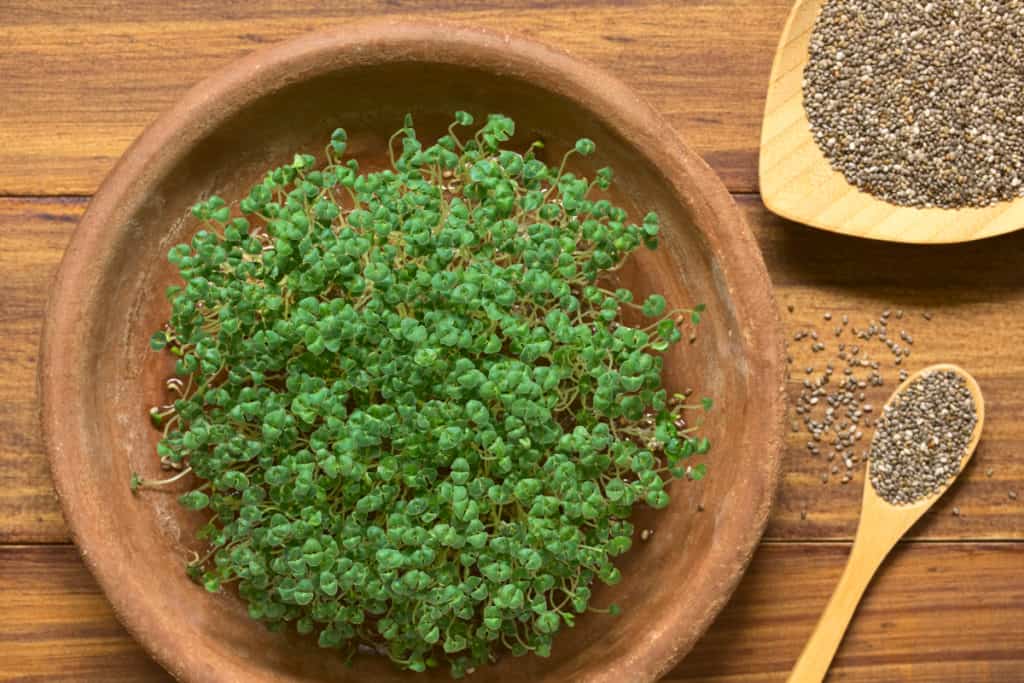
How to grow chia sprouts step-by-step
Since chia has a mucilaginous seed it requires a different growing method. You’ll also need a few different supplies and materials.
We’ll show you how to grow chia sprouts three different ways:
- Using the dry seed method with a terracotta dish.
- Using a sprouting bag.
- Using a growing medium (as microgreens).
Chia seeds grow best at room temperature, roughly 70-80 degrees Fahrenheit (21-27 degrees Celsius). Keep away from direct sunlight.
Note: 1 tablespoon of chia seeds yields roughly 1.5 tablespoons of chia sprouts.
How long does it take for chia seeds to sprout?
There are many factors that affect how long it takes for seeds to sprout, including room temperature and moisture levels. On average, most sprouted chia seeds are ready to eat between 2 and 7 days, depending on your preference.
Chia microgreens take longer to grow. You can harvest microgreens sometime between days 5 and 14.
#1: Growing chia sprouts with a terracotta dish: dry seed method
Ever wondered how to grow chia seeds without soil? The following method is super-simple and uses a terracotta dish. Why use a terracotta dish? Terracotta is a natural, porous material that allows for good airflow. This prevents your chia sprouting seeds from getting too moist, which could lead to a bad batch of sprouts.
If you don’t have terracotta, a glass dish could also work. Just be sure to carefully monitor the moisture levels in your chia. (Too much moisture can lead to mold growth and foodborne illness).
When chia seeds sprout in this manner, the entire plant is eaten. This type of sprouted chia produces a soft and tender plant.
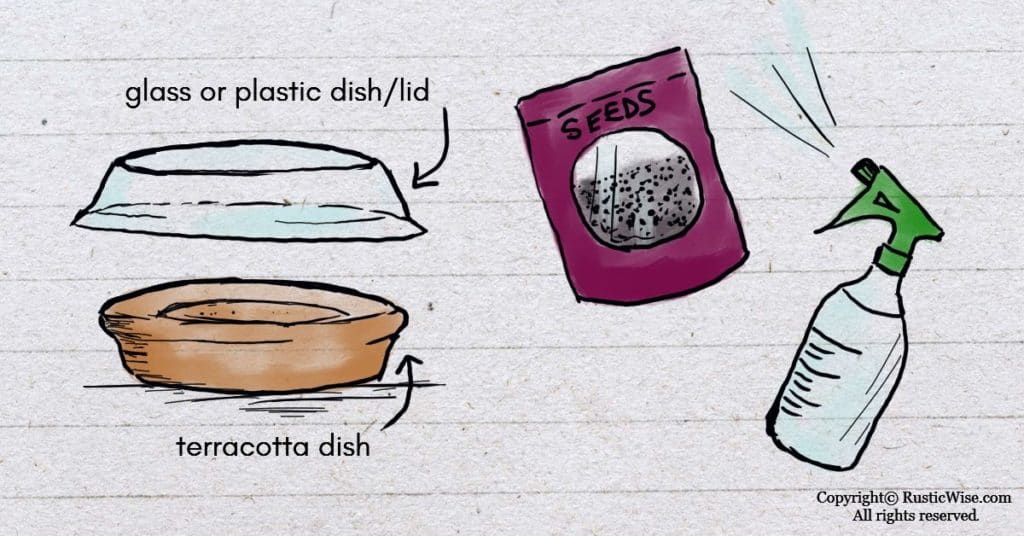
You’ll need:
- A water sprayer (with distilled water, or water of drinking quality)
- A clean terracotta dish
- Something to create a mini greenhouse that fits over your terracotta dish. This could be a clear plastic clamshell lid, a glass Pyrex pie dish, or even a plastic bag.
- Organic chia seeds
- Moisten the terracotta dish thoroughly by misting with cool water.
- Sprinkle dry chia seeds onto the clean, moistened terracotta dish. Start with one teaspoon and add more as necessary. Distribute chia seeds evenly across the bottom of the dish so that they form a single thin layer and don’t overlap.
- Spray chia seeds with a bottle sprayer, ensuring they all are wet. Allow chia seeds to absorb water for 1 hour. After 1 hour, spray again.
- Place in a warm area away from direct sunlight. Place your mini greenhouse cover over the terracotta dish to keep moisture in. Leave your cover on for the first 2-3 days. You can remove the cover when you see some healthy growth.
- Continue misting your chia seeds twice a day. You’ll begin to see growth as early as day two or three.
Optional: You can place your sprouted chia seeds in sunlight for a few hours before harvesting to “green” them, but this isn’t necessary. - Harvest when sprouts are between 0.5-2 inches (1-5 centimeters). This may be any time from 2 to 7 days depending on your preference.
Other ways to sprout chia seeds
If you don’t have a terracotta dish, check out these other ways to grow chia sprouts.
#2: Outside a hemp bag
While larger sprouting seeds like legumes or grains are usually grown inside a sprouting bag, smaller seeds like chia can also grow with a hemp sprouting bag. To do this, place the sprouting bag on a plate or shallow dish. (Chia seeds are small, this prevents them from falling through the cracks.)
Using similar instructions as the ones above, just sprinkle a layer of chia seeds onto the bottom of a spouting bag. Spray with water twice a day. Roll the bag’s edges down to give the seeds some light and airflow. In this way, your seeds are growing on the “outside” of the hemp bag.
#3: In a sprouting medium (as chia microgreens)
The difference between sprouts and microgreens is that sprouts are eaten whole (root, shoot, and leaf). Microgreens take root in a growing medium like coconut coir, potting soil, or an unbleached paper towel.
Growing micros is another great way of growing chia seeds indoors, and enjoying this nutritious green.
The chia microgreens are harvested just above the soil line. The growing process of chia microgreens is similar to chia sprouts, however, typically, microgreens have a longer growing period. Chia seeds grown as microgreens may have a slightly firmer texture (more crunch) than sprouted chia seeds.
You’ll need a growing tray, pie plate, or something similar to place your growing medium on.
- Thoroughly moisten growing medium.
- Sprinkle seeds evenly over the growing medium.
- Place a glass or plastic cover to create a mini greenhouse.
- When your chia seeds have sprouted, remove the cover and place in a sunnier location.
- Continue misting with water twice a day. Chia microgreens are ready to harvest in 5-14 days.
How to harvest and store chia sprouts
To harvest chia sprouts, just place in a colander and gently rinse. Allow sprouted chia to thoroughly dry before storing in the fridge. Chia sprouts may keep up to one week in the fridge. Although, like other healthy sprouts, they taste best when eaten fresh or within 2-3 days. They keep best in some type of container with airflow, such as a perforated plastic bag, or a Tupperware container with air vents.
If you are growing chia microgreens (sprouted in soil or other growing medium), you simply snip them with a pair of scissors just above the soil line.
Other chia FAQs
What’s the difference between black and white chia seeds?
While most chia seeds you see in stores are black, there are also white varieties. Both black and white chia seeds have the same nutritional content. If you look closely at your package of store-bought chia seeds, you’ll probably see some white chia seeds too.
Does eating too much chia seeds hurt your stomach?
While there are plenty of good reasons to eat chia seeds and sprouts, it is possible to overdo it. Chia seeds in particular (as noted above), are rich in fiber. It’s known that excessive fiber intake may cause bloating and gassiness. So like all foods, remember to eat chia in moderation.
Can you eat chia sprouts from a Chia Pet?
While technically your adorable Chia Pet is growing chia seeds indoors, it’s not recommended to chow down on them. The seeds used for your terracotta pet are not thoroughly washed and have not been approved by the U.S. Food & Drug Administration as food-grade.
Instead, try growing your own tiny greens from organic, food-safe varieties found at a local seed supplier.
Can cats eat chia sprouts?
Yes, cats can eat chia sprouts. The ASPCA does not list the chia plant as toxic on its website. But like all good things, it should be consumed in moderation, as too much can make your feline friend sick.
Did you know that you can grow chia cat grass from Chia Pets? This type of grass is made for cat consumption.
👉 If you like this post, see our Essential Sprouting Guide: How To Grow Sprouts at Home. 🌱
Would you like more timeless tips via email?
Fun tips to help you live an independent, self-sustaining lifestyle. Opt-out at any time.


References
- Britannica, Chia plant, https://www.britannica.com/plant/chia. Accessed April 2023.
- Evans, Doug (2020). The Sprout Book: Tap into the Power of the Planet’s Most Nutritious Food. St. Martin’s Publishing Group. ebook.
- My Food Data, Chia Seeds, https://tools.myfooddata.com/nutrition-facts/170554/wt1. Accessed April 2023.

Author: Josh Tesolin
Josh is co-founder of RusticWise. When he’s not tinkering in the garden, or fixing something around the house, you can find him working on a vast array of random side projects.

